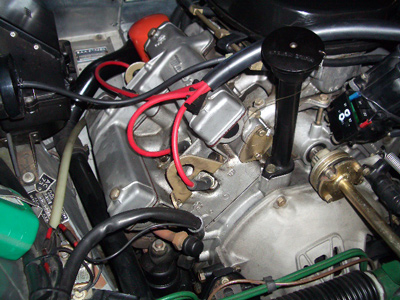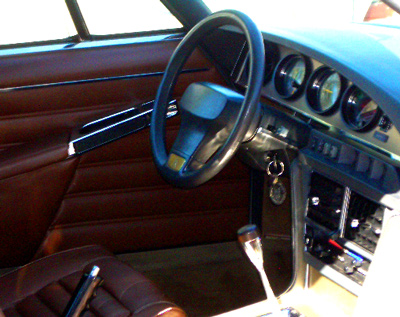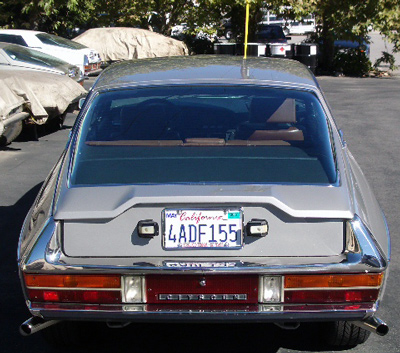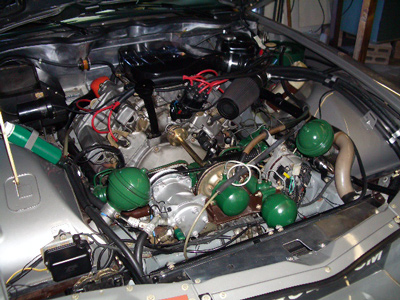The reputation of the CitroŽn SM precedes most of our actual knowledge of the car itself. Frighteningly complex hydraulics, rusty uni-bodies, electrical gremlins and unobtanium parts all immediately come to mind when considering the car. While these descriptors can apply to many cars, they are particularly associated with CitroŽns here in the States.
It is only upon careful consideration of the SM, its historical place and technological sophistication that one begins to truly appreciate its qualities. When Jerry Hathaway of SM World remarked about a SM he had recently sold to a M.I.T. Professor: ďhe had the brains to buy the best he could affordĒ it wasnít totally clear whether he meant that particular example or a SM in general.
For the SM is a thinking manís car. And a technological tour de force. Aesthetically pleasing in its Gallic way, from the exterior it is far removed from its obvious sporting competitors, the V12 Lamborghini Espada, Maserati Bora and Aston Martin DBS. Contemporary road tests typically mentioned the Mercedes and BMW models of its day, but these cars have long faded in comparison, with the SM remaining an icon of its era.

Futuristic styling of the SM reflected CitroŽn's design philosophy and the DS-19 series.
|
Jerry was a front-end mechanic in 1972 at Irv White Buick in Los Angeles when the dealership began carrying the SM. CitroŽn had plenty at stake with the SM and dealers had to meet certain presentation standards. This meant forsaking Charlie Dirscherl's nearby Challenger Motors in Hollywood, which had been importing CitroŽns since before WWII, for the modern showroom of Irv White. After seven long years of lucrative, but routine, work Jerry was ready for a challenge. The SM with its complex hydraulics immediately captivated him.

As the result of what might be called a merger with Maserati, CitroŽn was able to use the
V-6 designed for the Maserati Merak.
|
In 1974 Jerry left Irv White for an independent shop where he was only going to work on CitroŽns. When this didnít work to his satisfaction, he opened his own shop on Sepulveda Blvd. in Van Nuys on September, 1976. In 1992 Jerry relocated the business to Santa Clarita. Now over thirty years later, he focuses exclusively on SMs at his shop SM World,just off the Interstate 5, north of Los Angeles.

If the engine was all Italian, the interior was most definitely French.
|
According to Brian Long & Philippe Claverol in their recently published (Veloce, 2006) book entitled: ďSM, CitroŽnís Maserati-engined SupercarĒ CitroŽn had been working on developing a luxury touring car since the early 1960ís. When CitroŽn bought Maserati in 1968, they gained access to the final piece required, a 2.7L 90-degree V6. The pollination worked both ways with CitroŽn receiving power plants and Maserati, hydraulic technology. This Maserati would apply to the Merak, Khamsin & Bora. Not surprisingly the Merak hydraulic pump is the same as that in the SM, and the CitroŽn DS pump was used in the Khamsin and Bora.

There ain't nothing like a dame, or a CitroŽn. They never copied ANYBODY.
|
The Maserati engine originally displaced 2.7L with 170 hp and was installed in the 1971 through mid-1973 cars (SB chassis prefix). In 1973, the engine displacement was increased to 3L for the duration of the production run (SD chassis prefix). This engine produced 180 hp, but more importantly torque was up.

The brillian green pods are part of the complex hydraulic system, also a legacy from the DS.
|
While the 2.7L engine was relatively robust, the 3L engine consumed oil in large quantities from new. Jerry relates the story of customers bringing in their new SMs for the 6,000 mile oil change with only half a quart remaining in the sump. The cast iron oil rings wore quickly and soon the engines were consuming eight quarts every 3,000 miles. Typically this showed up as extensive engine-bearing wear by 50K-60K miles. When rebuilt with standard US 3-piece oil rings, the consumption drops to minimal and most cars today have been so retro-fitted.
Total SM production numbered 12,920 cars with 1,729 arriving in the US by 1973. In the latter part of that year, DOT regulations changed and the balance of the cars originally destined for the US ended up in Japan. Japan typically received Euro-spec cars but for these approximately 300 U.S.-spec cars. World wide, SM production ran from 1971 to 1975. By 1975 the oil crisis had killed most luxury car sales and the SM was no exception.
Designed as a four-seater Grand Tourer, the SMís rear seats are impractical for most adults. Or at least four super-sized Americans. Yet at sixteen feet in length it is a substantially-sized two-seater. Again quoting Long & Claverol, contemporary road testers gave the car high praise for its comfortable ride, positive but light self-centering steering and the engineís peppy performance. Opinions on the clutch appeared to vary depending on whether the reviewer viewed the car as a gran boulevardier or sportscar.
Performance was sufficient to support either view. Top speed was quoted at 135 mph although there were reports of unmodified 150 mph speeds. Jerry broke 200 mph in his modified SM race-car at Bonneville. The low CD of 0.33 allowed a stock 0-60 time of around nine seconds. Riding in a 5-spd version recently, the car kept up easily with modern traffic while the engine throbbed merrily away.
Then there is the question of styling. Itís one of those - you either love it or hate it. With the return of the 70ís in fashion & style, the car looks quite hip once again. The overall shape, enclosed nose and wheel spats combine to make the car appear futuristically aero. Jerry reports that a significant number of current SM owners are pilots, both private and commercial. Whether itís the feel of the controls, the streamlined shape or both that attracts them, he wasnít sure. Or perhaps itís the cost of owning one.
SMs never were inexpensive with US list prices in excess of $13,000 by 1973. While appearing relatively insignificant in todayís dollars, consider that in 1974 Jerry took $10,000 he had saved towards buying a new SM and bought a $33,000 house in Granada Hills instead. Current prices remain strong with good examples trading from the high $20Kís and up. Itís not uncommon for an excellent car to bring upward of $50,000. This appears to be a great deal when one considers that it can cost $80K - $90K to do a full restoration.
Individual parts and the associated repair work can be expensive Ė Jerry recommends buying the best one that you can afford and making sure that it is fully checked out by someone who works on the cars frequently - before buying it.
Regular maintenance is critical with the suspension spheres having a life expectancy of five years, the pressure regulator and brake accumulators six years and the cylinder boots only three to four years. Old age is the enemy of these cars, which coupled with the maintenance of the hydraulic system makes a caring owner essential.

The SM distributor cap and long screwdriver. Don't leave home without it.
|
With that, the SM can be tremendously reliable and trouble free. Jerry once bought a 230,000 mile car, changed the oil, lubed it and promptly drove it to Spokane, non-stop. All he carried was a spare distributor cap, which no SM owner should ever leave home without, and the long screwdriver required to change it.
For the selective few, the SM remains one of the worldís foremost GT cars. Excellent performance, futuristic styling and bar-setting technical specifications combine to create an unforgettable experience.



